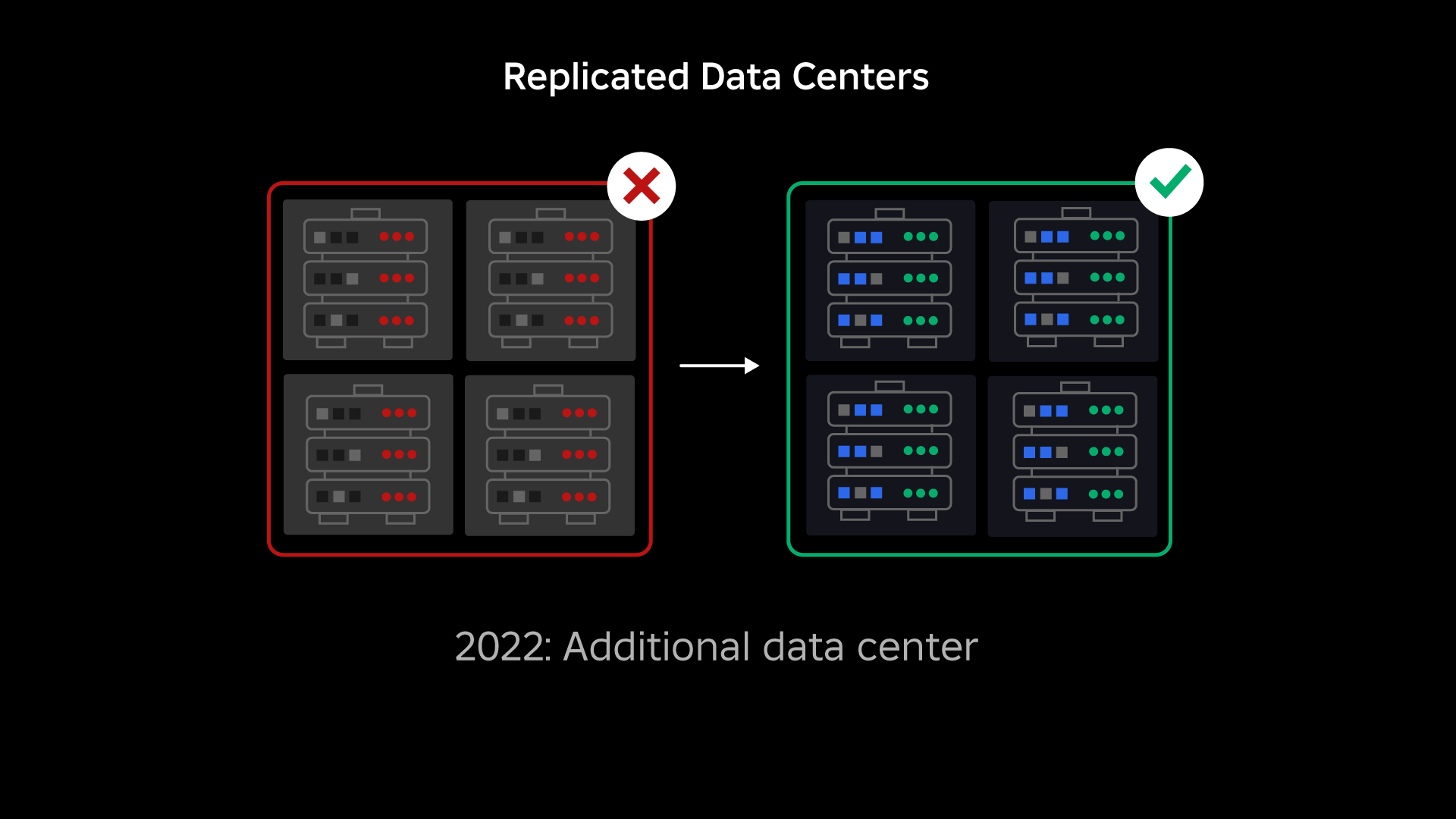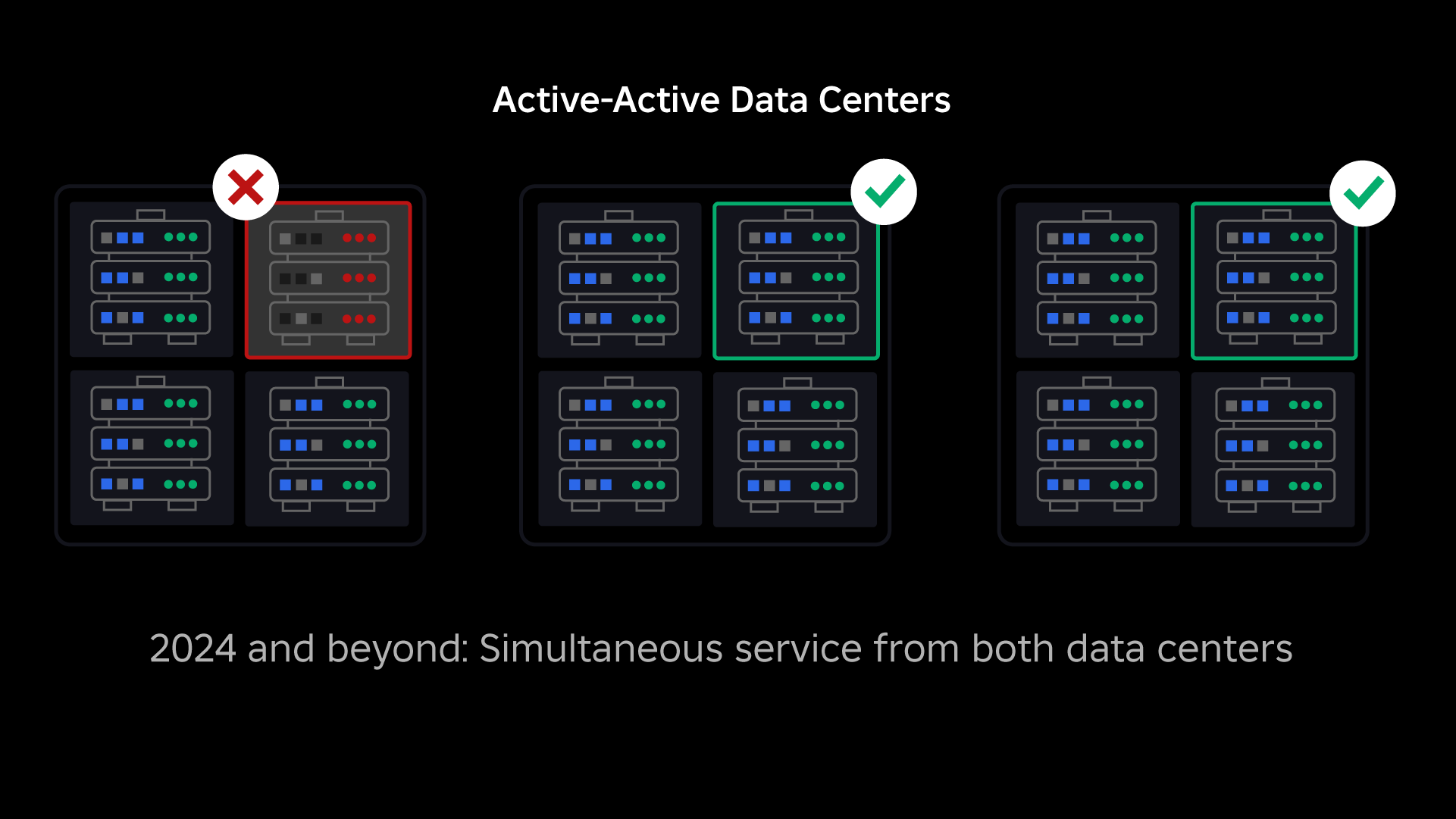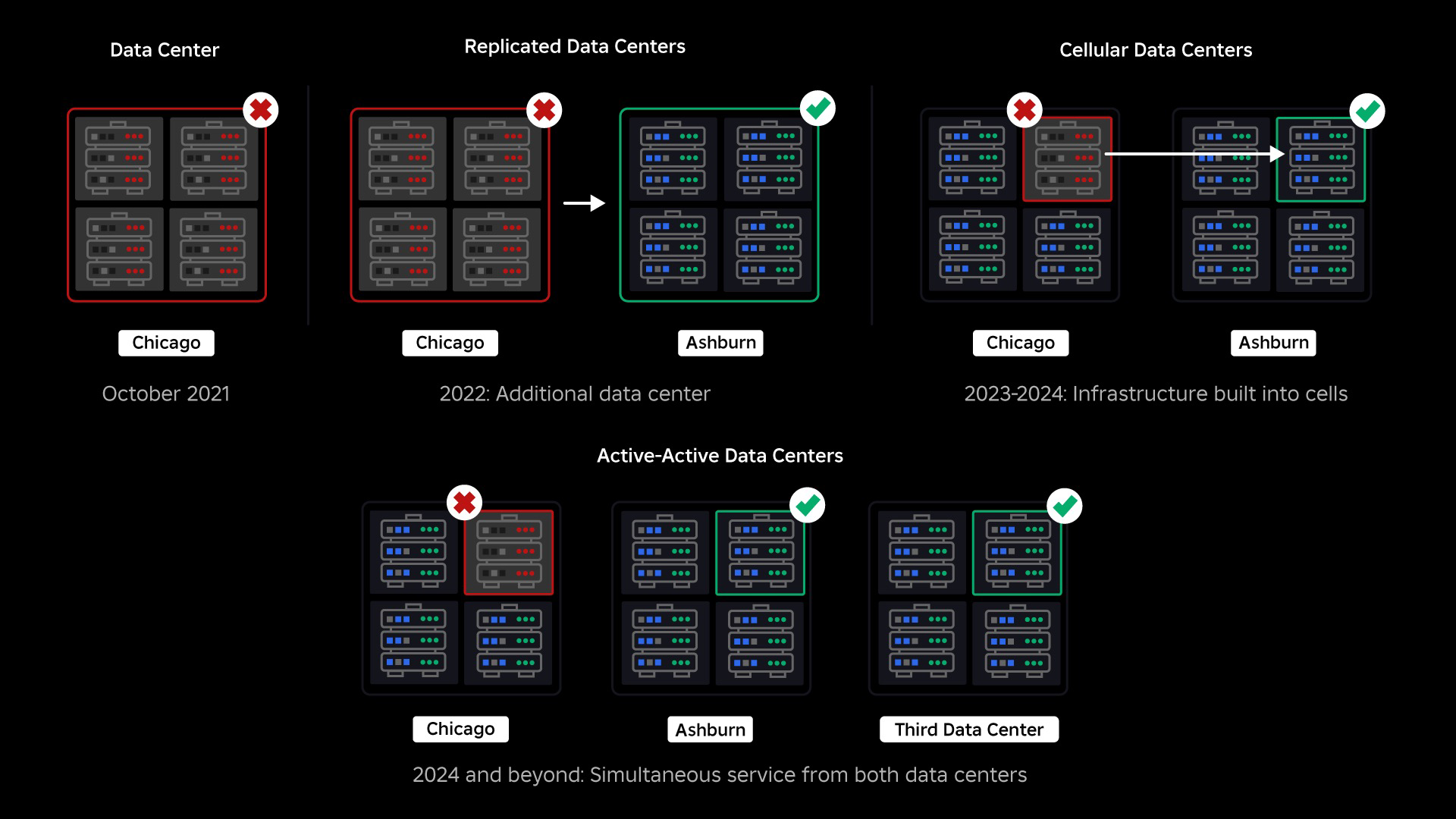As Roblox has grown over the previous 16+ years, so has the dimensions and complexity of the technical infrastructure that helps hundreds of thousands of immersive 3D co-experiences. The variety of machines we assist has greater than tripled over the previous two years, from roughly 36,000 as of June 30, 2021 to just about 145,000 at this time. Supporting these always-on experiences for individuals all around the world requires greater than 1,000 inside companies. To assist us management prices and community latency, we deploy and handle these machines as a part of a custom-built and hybrid non-public cloud infrastructure that runs totally on premises.
Our infrastructure at present helps greater than 70 million each day lively customers around the globe, together with the creators who depend on Roblox’s financial system for his or her companies. All of those hundreds of thousands of individuals anticipate a really excessive degree of reliability. Given the immersive nature of our experiences, there’s an especially low tolerance for lags or latency, not to mention outages. Roblox is a platform for communication and connection, the place individuals come collectively in immersive 3D experiences. When individuals are speaking as their avatars in an immersive area, even minor delays or glitches are extra noticeable than they’re on a textual content thread or a convention name.
In October, 2021, we skilled a system-wide outage. It began small, with a difficulty in a single part in a single knowledge middle. But it surely unfold shortly as we have been investigating and in the end resulted in a 73-hour outage. On the time, we shared each particulars about what occurred and a few of our early learnings from the difficulty. Since then, we’ve been finding out these learnings and working to extend the resilience of our infrastructure to the forms of failures that happen in all large-scale methods on account of elements like excessive site visitors spikes, climate, {hardware} failure, software program bugs, or simply people making errors. When these failures happen, how will we make sure that a difficulty in a single part, or group of parts, doesn’t unfold to the complete system? This query has been our focus for the previous two years and whereas the work is ongoing, what we’ve completed to this point is already paying off. For instance, within the first half of 2023, we saved 125 million engagement hours monthly in comparison with the primary half of 2022. Right this moment, we’re sharing the work we’ve already completed, in addition to our longer-term imaginative and prescient for constructing a extra resilient infrastructure system.
Constructing a Backstop
Inside large-scale infrastructure methods, small scale failures occur many occasions a day. If one machine has a difficulty and must be taken out of service, that’s manageable as a result of most firms preserve a number of situations of their back-end companies. So when a single occasion fails, others decide up the workload. To deal with these frequent failures, requests are usually set to routinely retry in the event that they get an error.
This turns into difficult when a system or particular person retries too aggressively, which might turn into a approach for these small-scale failures to propagate all through the infrastructure to different companies and methods. If the community or a consumer retries persistently sufficient, it’ll ultimately overload each occasion of that service, and doubtlessly different methods, globally. Our 2021 outage was the results of one thing that’s pretty widespread in massive scale methods: A failure begins small then propagates via the system, getting massive so shortly it’s onerous to resolve at first goes down.
On the time of our outage, we had one lively knowledge middle (with parts inside it performing as backup). We would have liked the flexibility to fail over manually to a brand new knowledge middle when a difficulty introduced the prevailing one down. Our first precedence was to make sure we had a backup deployment of Roblox, so we constructed that backup in a brand new knowledge middle, positioned in a special geographic area. That added safety for the worst-case situation: an outage spreading to sufficient parts inside an information middle that it turns into totally inoperable. We now have one knowledge middle dealing with workloads (lively) and one on standby, serving as backup (passive). Our long-term purpose is to maneuver from this active-passive configuration to an active-active configuration, by which each knowledge facilities deal with workloads, with a load balancer distributing requests between them based mostly on latency, capability, and well being. As soon as that is in place, we anticipate to have even increased reliability for all of Roblox and have the ability to fail over almost instantaneously fairly than over a number of hours.

Shifting to a Mobile Infrastructure
Our subsequent precedence was to create robust blast partitions inside every knowledge middle to cut back the potential for a complete knowledge middle failing. Cells (some firms name them clusters) are basically a set of machines and are how we’re creating these partitions. We replicate companies each inside and throughout cells for added redundancy. In the end, we would like all companies at Roblox to run in cells to allow them to profit from each robust blast partitions and redundancy. If a cell is now not practical, it could possibly safely be deactivated. Replication throughout cells allows the service to maintain operating whereas the cell is repaired. In some instances, cell restore may imply a whole reprovisioning of the cell. Throughout the trade, wiping and reprovisioning a person machine, or a small set of machines, is pretty widespread, however doing this for a complete cell, which comprises ~1,400 machines, isn’t.
For this to work, these cells have to be largely uniform, so we are able to shortly and effectively transfer workloads from one cell to a different. We have now set sure necessities that companies want to satisfy earlier than they run in a cell. For instance, companies have to be containerized, which makes them way more transportable and prevents anybody from making configuration modifications on the OS degree. We’ve adopted an infrastructure-as-code philosophy for cells: In our supply code repository, we embody the definition of the whole lot that’s in a cell so we are able to rebuild it shortly from scratch utilizing automated instruments.
Not all companies at present meet these necessities, so we’ve labored to assist service homeowners meet them the place potential, and we’ve constructed new instruments to make it simple emigrate companies into cells when prepared. For instance, our new deployment instrument routinely “stripes” a service deployment throughout cells, so service homeowners don’t have to consider the replication technique. This degree of rigor makes the migration course of way more difficult and time consuming, however the long-term payoff might be a system the place:
- It’s far simpler to include a failure and stop it from spreading to different cells;
- Our infrastructure engineers could be extra environment friendly and transfer extra shortly; and
- The engineers who construct the product-level companies which are in the end deployed in cells don’t have to know or fear about which cells their companies are operating in.
Fixing Larger Challenges
Much like the best way fireplace doorways are used to include flames, cells act as robust blast partitions inside our infrastructure to assist include no matter situation is triggering a failure inside a single cell. Ultimately, all the companies that make up Roblox might be redundantly deployed inside and throughout cells. As soon as this work is full, points might nonetheless propagate huge sufficient to make a complete cell inoperable, however it might be extraordinarily troublesome for a difficulty to propagate past that cell. And if we reach making cells interchangeable, restoration might be considerably sooner as a result of we’ll have the ability to fail over to a special cell and hold the difficulty from impacting finish customers.
The place this will get tough is separating these cells sufficient to cut back the chance to propagate errors, whereas retaining issues performant and practical. In a fancy infrastructure system, companies want to speak with one another to share queries, data, workloads, and many others. As we replicate these companies into cells, we have to be considerate about how we handle cross-communication. In an excellent world, we redirect site visitors from one unhealthy cell to different wholesome cells. However how will we handle a “question of loss of life”—one which’s inflicting a cell to be unhealthy? If we redirect that question to a different cell, it could possibly trigger that cell to turn into unhealthy in simply the best way we’re making an attempt to keep away from. We have to discover mechanisms to shift “good” site visitors from unhealthy cells whereas detecting and squelching the site visitors that’s inflicting cells to turn into unhealthy.
Within the brief time period, we have now deployed copies of computing companies to every compute cell so that the majority requests to the information middle could be served by a single cell. We’re additionally load balancing site visitors throughout cells. Trying additional out, we’ve begun constructing a next-generation service discovery course of that might be leveraged by a service mesh, which we hope to finish in 2024. This can permit us to implement subtle insurance policies that may permit cross-cell communication solely when it gained’t negatively impression the failover cells. Additionally coming in 2024 might be a technique for guiding dependent requests to a service model in the identical cell, which is able to reduce cross-cell site visitors and thereby scale back the chance of cross-cell propagation of failures.
At peak, greater than 70 p.c of our back-end service site visitors is being served out of cells and we’ve discovered so much about how you can create cells, however we anticipate extra analysis and testing as we proceed emigrate our companies via 2024 and past. As we progress, these blast partitions will turn into more and more stronger.

Migrating an always-on infrastructure
Roblox is a worldwide platform supporting customers all around the world, so we are able to’t transfer companies throughout off-peak or “down time,” which additional complicates the method of migrating all of our machines into cells and our companies to run in these cells. We have now hundreds of thousands of always-on experiences that have to proceed to be supported, at the same time as we transfer the machines they run on and the companies that assist them. After we began this course of, we didn’t have tens of hundreds of machines simply sitting round unused and accessible emigrate these workloads onto.
We did, nevertheless, have a small variety of further machines that have been bought in anticipation of future development. To begin, we constructed new cells utilizing these machines, then migrated workloads to them. We worth effectivity in addition to reliability, so fairly than going out and shopping for extra machines as soon as we ran out of “spare” machines we constructed extra cells by wiping and reprovisioning the machines we’d migrated off of. We then migrated workloads onto these reprovisioned machines, and began the method another time. This course of is complicated—as machines are changed and free as much as be constructed into cells, they aren’t releasing up in an excellent, orderly style. They’re bodily fragmented throughout knowledge halls, leaving us to provision them in a piecemeal style, which requires a hardware-level defragmentation course of to maintain the {hardware} places aligned with large-scale bodily failure domains.
A portion of our infrastructure engineering group is concentrated on migrating present workloads from our legacy, or “pre-cell,” surroundings into cells. This work will proceed till we’ve migrated hundreds of various infrastructure companies and hundreds of back-end companies into newly constructed cells. We anticipate this may take all of subsequent 12 months and probably into 2025, on account of some complicating elements. First, this work requires sturdy tooling to be constructed. For instance, we want tooling to routinely rebalance massive numbers of companies after we deploy a brand new cell—with out impacting our customers. We’ve additionally seen companies that have been constructed with assumptions about our infrastructure. We have to revise these companies so they don’t depend on issues that might change sooner or later as we transfer into cells. We’ve additionally carried out each a option to seek for identified design patterns that gained’t work properly with mobile structure, in addition to a methodical testing course of for every service that’s migrated. These processes assist us head off any user-facing points brought on by a service being incompatible with cells.
Right this moment, near 30,000 machines are being managed by cells. It’s solely a fraction of our complete fleet, nevertheless it’s been a really clean transition to this point with no destructive participant impression. Our final purpose is for our methods to realize 99.99 p.c consumer uptime each month, which means we’d disrupt not more than 0.01 p.c of engagement hours. Trade-wide, downtime can’t be utterly eradicated, however our purpose is to cut back any Roblox downtime to a level that it’s almost unnoticeable.
Future-proofing as we scale
Whereas our early efforts are proving profitable, our work on cells is way from completed. As Roblox continues to scale, we are going to hold working to enhance the effectivity and resiliency of our methods via this and different applied sciences. As we go, the platform will turn into more and more resilient to points, and any points that happen ought to turn into progressively much less seen and disruptive to the individuals on our platform.
In abstract, so far, we have now:
- Constructed a second knowledge middle and efficiently achieved lively/passive standing.
- Created cells in our lively and passive knowledge facilities and efficiently migrated greater than 70 p.c of our back-end service site visitors to those cells.
- Set in place the necessities and finest practices we’ll have to comply with to maintain all cells uniform as we proceed emigrate the remainder of our infrastructure.
- Kicked off a steady means of constructing stronger “blast partitions” between cells.
As these cells turn into extra interchangeable, there might be much less crosstalk between cells. This unlocks some very fascinating alternatives for us when it comes to growing automation round monitoring, troubleshooting, and even shifting workloads routinely.
In September we additionally began operating lively/lively experiments throughout our knowledge facilities. That is one other mechanism we’re testing to enhance reliability and reduce failover occasions. These experiments helped determine quite a few system design patterns, largely round knowledge entry, that we have to rework as we push towards turning into absolutely active-active. General, the experiment was profitable sufficient to depart it operating for the site visitors from a restricted variety of our customers.

We’re excited to maintain driving this work ahead to deliver larger effectivity and resiliency to the platform. This work on cells and active-active infrastructure, together with our different efforts, will make it potential for us to develop right into a dependable, excessive performing utility for hundreds of thousands of individuals and to proceed to scale as we work to attach a billion individuals in actual time.

